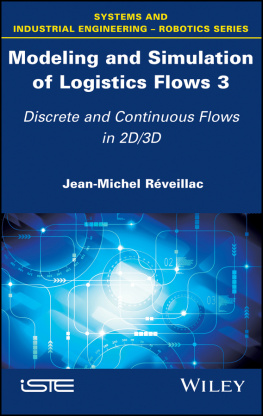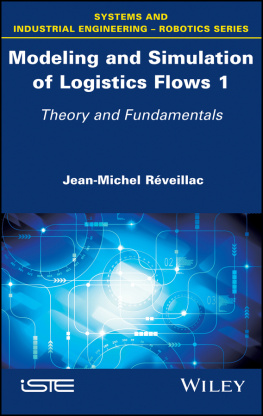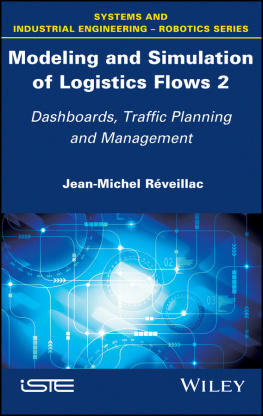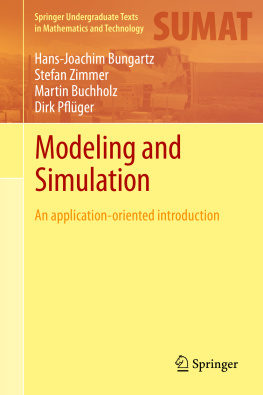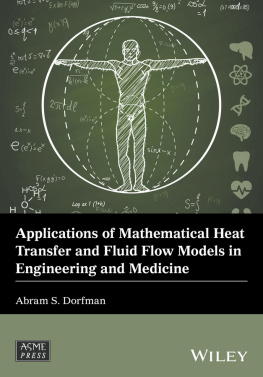
Series Editor
Jean-Paul Bourrires
Modeling and Simulation of Logistics Flows 3
Discrete and Continuous Flows in 2D/3D
Jean-Michel Rveillac
First published 2017 in Great Britain and the United States by ISTE Ltd and John Wiley & Sons, Inc.
Apart from any fair dealing for the purposes of research or private study, or criticism or review, as permitted under the Copyright, Designs and Patents Act 1988, this publication may only be reproduced, stored or transmitted, in any form or by any means, with the prior permission in writing of the publishers, or in the case of reprographic reproduction in accordance with the terms and licenses issued by the CLA. Enquiries concerning reproduction outside these terms should be sent to the publishers at the undermentioned address:
ISTE Ltd
27-37 St Georges Road
London SW19 4EU
UK
www.iste.co.uk
John Wiley & Sons, Inc.
111 River Street
Hoboken, NJ 07030
USA
www.wiley.com
ISTE Ltd 2017
The rights of Jean-Michel Rveillac to be identified as the author of this work have been asserted by him in accordance with the Copyright, Designs and Patents Act 1988.
Library of Congress Control Number: 2016956897
British Library Cataloguing-in-Publication Data
A CIP record for this book is available from the British Library
ISBN 978-1-78630-108-6
About This Book
There are already several works about logistics, operational research, decision support, the theory of graphs, dynamic programming, etc., but few of them gather all of these domains together by proposing an overall vision that focuses less on pure and hard mathematical aspects, without totally ignoring them, while offering numerous practical exercises.
This book is one of three volumes. This first volume tackles theoretical aspects with corrected exercises for each chapter, finishing with a presentation of the principal software systems dedicated to operational research (OR) and logistical simulation. The second and third volumes are dedicated to practice and specialized applications of software programs.
Most of the studies proposed here are able to be completed using a simple calculator, a sheet of paper and a pen or even with the help of a spreadsheet on Microsoft Excel, Apache OpenCalc, Apple Numbers, etc.
The presented techniques and their uses are multiple, yet I am sure that a student, a software programmer, a developer, a technician, an engineer, an IT specialist, a decision-maker and you, the reader, will find practical applications that were unexpected in your professional or even personal life.
Intended public
This work is designed for all those who encounter logistical problems linked to flux management, decision support, optimization of journeys or rounds, research for an aim when confronted with multiple constraints, creation of dashboards, relevant simulations, etc.
The works presented require a minimum level of mathematical knowledge, and a post A level student in science or economics will not encounter major difficulties. I tried to maintain simplicity and go straight toward the objective in the theoretical approach without going into great demonstrations, which to me do not seem necessary.
In terms of the practical exercises, on a laptop, tackled in Volumes 2 and 3, a good knowledge of the exploitation system (track, records and lists, files, names, extensions, sheet, movement, etc.) will prove essential.
Since a few works use a spreadsheet, it is thus necessary to master the basic functionalities of this type of software program. It will also be convenient to know the primary use of pivot table data manipulation tools.
If we know about visual basic application (VBA) language or its equivalent, we can easily understand, improve, enrich and create new solutions to certain problems.
Lastly, if we understand the basic systems for managing data and relational algebra, then we will be at ease in every domain explored.
Organization and contents of the book
This work is composed of three volumes:
- Volume 1: Theory and fundamentals;
- Volume 2: Dashboards, traffic planning and management;
- Volume 3: Discrete and continuous flows in 2D/3D.
Volume 1 presents an introduction followed by 10 chapters and a conclusion:
- approach for logistics;
- an overall view of operational research;
- basics of the theory of graphs;
- calculation of optimal routes;
- dynamic programming;
- planning and scheduling with PERT and MPM;
- calculation of waves in a network;
- hiding trees and tours;
- linear programming;
- modelization of route traffic;
- diverse software programs for RO and simulation of logistical flux.
Here, we will find the fundamental concepts needed in order to understand the second volume. Numerous examples accompany the theory and each chapter ends with a series of exercises with their solutions.
The conclusion, as indicated by the name, tries to establish a picture of the current state of theoretical logistics and its future development.
Appendices 1 and 2 bring a few other elements. We will find them in the following order:
- table of the law of the normal reduced center;
- a presentation and a mini-manual dedicated to the calculation software program GeoGebra.
Volume 2 starts with an introduction completed with four chapters that put into practice the software tools in cases of practical application in order to finish with a conclusion:
- the different tools used in this volume;
- operational research with a spreadsheet;
- dashboards with a spreadsheet;
- scheduling and planning with a project manager;
- simulation of route traffic.
The conclusion presents new functionalities that should appear on spreadsheets and project management systems as well as the evolutions and points of similarity between traffic simulators and new infrastructures that emerge in traffic networks.
Appendix 1 is dedicated to the installation of a solving tool in Microsoft Excel. Appendix 2 is consecrated to the installation of Java development kit.
Volume 3 starts with an introduction followed by four chapters dedicated to the modelization and simulation of flux in a 2D or 3D environment. Each case is different and taken from situations encountered in reality. A conclusion concludes this Volume 3:
- different software programs used in this third volume;
- simulation of discreet computerized flows;
- simulation of mixed flows;
- 3D flows and evacuation simulation;
- 3D flows for transporting and storing.
The conclusion conveys the future evolutions of software programs and their integration into society. At the end of each volume, we will find a bibliography and a list of Internet links. A glossary is also available that will elaborate on certain acronyms and some very specific terminology surrounding logistics and operational research.
Conventions
This book uses the following typographic conventions:
- italics: used exclusively for important terms used for the first time in the text, one can generally be found in the glossary at the end of the work mathematical terms, comments, equations, expressions or variables present in the theoretical and practical chapters among examples and exercises;
Next page
